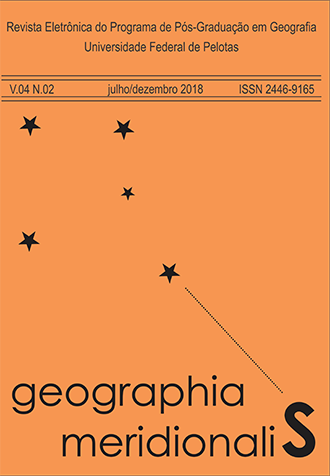ESCALAS GEOGRÁFICAS E IDENTIDADES TERRITORIALES: TRAYECTORIAS DESDE LAS COMUNIDADES NEGRAS DEL VALLE DEL PATÍA / GEOGRAPHICAL SCALES AND TERRITORIAL IDENTITIES: TRAJECTORIES FROM THE BLACK COMMUNITIES OF THE VALLE DEL PATÍA
Resumo
La escala geográfica y la identidad territorial representan importantes categorías para pensar procesos, interrelaciones y prácticas desplegadas en diferentes trayectorias espaciales e históricas. El objetivo de este trabajo es analizar cómo han operado simultáneamente los procesos de construcción de escala e identidad territorial en el Valle del Patía, sur de Colombia. Para lograr esto, basados en fuentes secundarias, reconocemos que este ámbito ha presentado tres trayectorias históricas y espaciales. La primera implicó la ocupación de espacios físicos, su apropiación y transformación en espacios culturales por negros cimarrones desde el siglo XVIII. La segunda, se vincula con la llegada de colonos mestizos en los años treinta del siglo XX, y una tercera con la implementación de dinámicas de modernización en la década de los años sesenta del siglo pasado, que implicaron la hibridación de prácticas socioculturales por parte de las comunidades negras. Como resultado, argumentamos que se configuraron múltiples co-relaciones entre actores-red que elaboraron redes escalares en mayor o menor densidad, de acuerdo con las prácticas hacia adentro y afuera. Es desde el adentro que se empoderó la identidad territorial negra, y a partir del afuera, se definió la interrelación de esta con lo mestizo en el Valle del Patía.
ABSTRACT:
The geographical scale and territorial identity represent important categories to think processes, interrelations and practices displayed in different spatial and historical trajectories. The aim of this paper is to analyze how the processes of scale construction and territorial identity have operated simultaneously in the Patía Valley, southern Colombia. To achieve this, based on secondary sources, we recognize that this ambit has presented three historical and spatial trajectories. The first involved the occupation of physical spaces, their appropriation and transformation into cultural spaces by black Maroons since the 18th century. The second is linked to the arrival of mestizo colonists in the thirties of the 20th century, and a third with the implementation of dynamics of modernization in the decade of the sixties of the last century, which implied the hybridization of sociocultural practices by black communities. As a result, we argued that multiple relationships were formed between network-actors that elaborated scalar networks in greater or lesser density, according to the practices inward and out. It is from the inward that the black territorial identity was empowered, and from the outside, the interrelation of this mestizo in the Patía Valley is defined.
Keywords: Patía Valley; Geographical Scale; Black Communities; Territorial Identities.
Downloads
Prezado autor: Utilize o modelo abaixo (link), preenchendo e enviando o arquivo digital em PDF como documento suplementar ao realizar a submissão de seu manuscrito.



